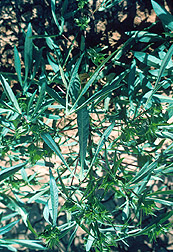This page has been archived and is being provided for reference purposes only. The page is no longer being updated, and therefore, links on the page may be invalid.
Details: Story in recent issue of Agricultural Research.
Strong, Comfy Cottons Result from Arizona Research
By Marcia Wood
July 12, 2000
Fabric woven from fluffy, white bolls of the pima cotton plant makes smooth, soft and durable clothing, as well as luxurious sheets, towels and other cotton goods. Today, virtually every type of pima cotton grown commercially in the United States has some parentage from pimas developed by plant breeders with the Agricultural Research Service.
For more than 40 years, ARS researchers in Arizona--in conjunction with University of Arizona scientists--have been producing superb new pima plants. They have offered more than 200 different pima genetic lines or varieties to cotton breeders in the United States and abroad, according to Richard G. Percy of the ARS Western Cotton Research Laboratory at Maricopa, Ariz.
The Arizona lab's newest pima genetic lines, for instance, are better able to fend off attack by pink bollworm and silverleaf whitefly, two major pests of cotton in the American West. The new lines also mature earlier than some other pima types, reducing the need for water, pesticides, and fertilizers.
Known to scientists as Gossypium barbadense, pima cotton is produced on some 200,000 hot, dry acres of desert in southern California and the Southwest. Tomorrow’s pimas may be even better equipped to endure the blistering heat.
About a decade ago, ARS and University of California at Los Angeles scientists noticed that some plants keep pores, called stomates, open longer as the day gets hotter, releasing moisture that then cools their leaves.
Now, a research team at New Mexico State University has pinpointed genetic markers that may, in turn, lead to genes that control the cooling-off trait. Once that happens, those genes could be shuttled into other cotton plants, giving them a new, natural way to produce high yields--despite the heat.
ARS is the U.S. Department of Agriculture’s chief research agency.
Scientific contact: Richard G. Percy, ARS Western Cotton Research Laboratory, Maricopa, Ariz., phone (602) 379-4221, fax (602) 379-4983, rpercy@ag.arizona.edu.

